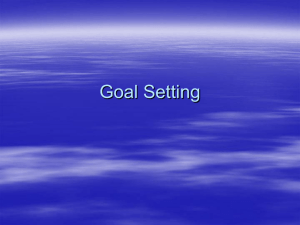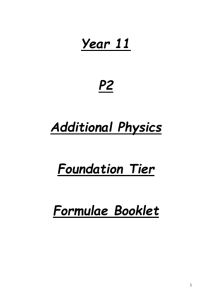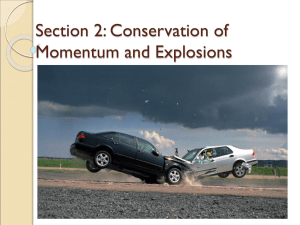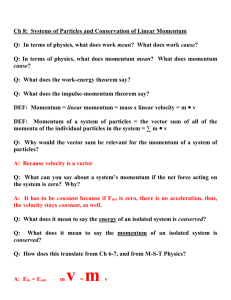PART IV: Application of Science to Martial Arts Sometimes the
advertisement
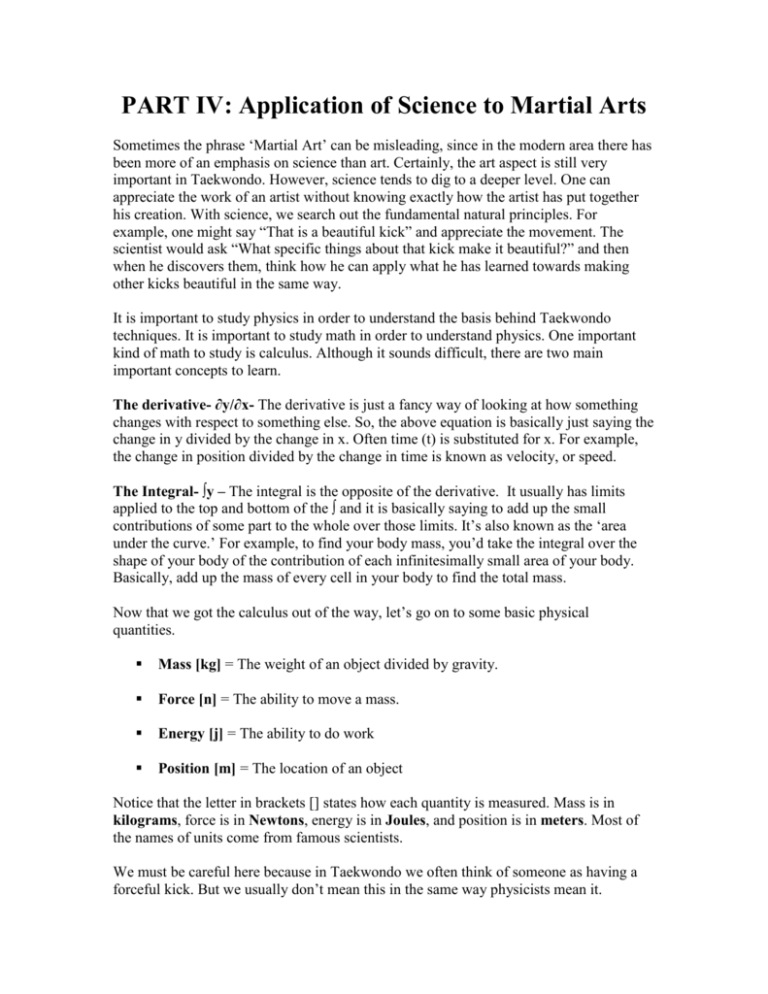
PART IV: Application of Science to Martial Arts Sometimes the phrase ‘Martial Art’ can be misleading, since in the modern area there has been more of an emphasis on science than art. Certainly, the art aspect is still very important in Taekwondo. However, science tends to dig to a deeper level. One can appreciate the work of an artist without knowing exactly how the artist has put together his creation. With science, we search out the fundamental natural principles. For example, one might say “That is a beautiful kick” and appreciate the movement. The scientist would ask “What specific things about that kick make it beautiful?” and then when he discovers them, think how he can apply what he has learned towards making other kicks beautiful in the same way. It is important to study physics in order to understand the basis behind Taekwondo techniques. It is important to study math in order to understand physics. One important kind of math to study is calculus. Although it sounds difficult, there are two main important concepts to learn. The derivative- ∂y/∂x- The derivative is just a fancy way of looking at how something changes with respect to something else. So, the above equation is basically just saying the change in y divided by the change in x. Often time (t) is substituted for x. For example, the change in position divided by the change in time is known as velocity, or speed. The Integral- ∫y – The integral is the opposite of the derivative. It usually has limits applied to the top and bottom of the ∫ and it is basically saying to add up the small contributions of some part to the whole over those limits. It’s also known as the ‘area under the curve.’ For example, to find your body mass, you’d take the integral over the shape of your body of the contribution of each infinitesimally small area of your body. Basically, add up the mass of every cell in your body to find the total mass. Now that we got the calculus out of the way, let’s go on to some basic physical quantities. Mass [kg] = The weight of an object divided by gravity. Force [n] = The ability to move a mass. Energy [j] = The ability to do work Position [m] = The location of an object Notice that the letter in brackets [] states how each quantity is measured. Mass is in kilograms, force is in Newtons, energy is in Joules, and position is in meters. Most of the names of units come from famous scientists. We must be careful here because in Taekwondo we often think of someone as having a forceful kick. But we usually don’t mean this in the same way physicists mean it. Let’s see what happens when we start applying derivatives to those four fundamental concepts. Let’s start with position. First let’s see how something’s position changes with time, ∂P/∂t. As stated above, we see that this is the object’s velocity. An important thing to note about velocity, however, is that it is a vector so it has two components, magnitude and direction. Thus, something can change its velocity by speeding up or slowing down, or by going at the same speed in a different direction. Velocity [m/s] = Change in position over time. V=∂P/∂t Now what happens if we take the derivative again? Acceleration is the term for how fast something’s velocity changes. Again, this can be a change in magnitude or direction. Acceleration is a key component in martial arts. If someone is fast, but fast all the time, then the opponent will be able to time them. If someone can change their speed or direction quickly, then they will be very difficult to beat. Acceleration [m/s2] = Change in velocity over time. A=∂V/∂t In order to find an object’s velocity, we can integrate the acceleration over time. We can integrate again (the velocity) to find an object’s position. If we do the same thing with energy, we find that the change in energy with respect to time is called Power. But the change in energy is also referred to the as Work, so we get two definitions for Power. Power [j/s or w] = Change in Energy over time. P=∂E/∂t Power is measured in Watts where one Watt equals one Joule/second. But what do we mean when we say that someone’s kick is powerful? We need a few more concepts to explain what happens when someone strikes another person. There are two critical things that happen- a transfer of momentum and a transfer and dissipation of energy. The first important concept in collisions is called momentum. Momentum is what is transferred from one body to another when they run into each other. The other important thing to note is that Momentum is always conserved. This means that all of the Momentum transferred from one body is absorbed by the other body. Momentum [kg m/s] = Mass times velocity m*v In a collision, we have that the Force equals the change in Momentum divided by the change in time, or F=∂M/∂t. This leads us to the second important concept, called Impulse. The Impulse is simply the Momentum delivered in a specific time. Impulse [kg m/s2] = Momentum delivered in a specific time. M*∂V/∂t As you can see from above, ∂V/∂t is really Acceleration, so this can also be stated as F=MA. In fact, this is known as Newton’s Second Law. All Momentum is delivered only if the two bodies are allowed to remain in contact for an infinite amount of time. For our purposes, when hitting another person, we have only a short amount of time in which to transfer our momentum. The next critical point is that of the transfer and dissipation of energy. There are many different kinds of energy. You have potential energy due to gravity and the chemical bonds in your body. You have energy stored in your muscles like a spring. But the most important for Taekwondo is your Kinetic Energy. This is just a fancy way of saying that you foot has energy because it is in motion. Kinetic Energy [j] = Energy of a moving object 1/2mv2 Just like momentum, Energy is conserved. It may change forms, sometimes to unusable forms like heat and sound, but it will not be totally lost. What happens when one person strikes another? There are two main kinds of kicks, pushing kicks and snapping kicks. Pushing kicks include linear kicks like cut kick, and front kick and back kick can also be done in a pushing way. Even roundhouse kick can be done to push, although this is rare. In pushing kicks, the main purpose is to move the other person’s body. Thus, the main equation is F=MA. You are trying to apply a Force in order to cause the other person’s body to undergo an Acceleration. What happens if the other person is big? M will be large and then that will make A small. This just proves what you already know, that if you kick a bigger person they will not go as far. However, because of the concept of impulse, if you are in contact with the person for a shorter time (lower t) there will be a larger change in (MV). Thus, hitting for a shorter time will let you move someone farther. Pushing kicks are not done to score, and the main scoring kicks are snapping kicks. In these kicks you are transferring momentum to the opponent and also transferring energy. Here the physics term Power comes in as the amount of Energy we can transfer in a specific time. Energy transfer is what is really important in snapping kicks, especially roundhouse kick. When your foot is in contact with a person, the Kinetic Energy from your foot is transferred to their chest protector. Some of this energy is transferred to heat energy, some is transferred to sound energy, and some penetrates into their body. Energy is the physical force that is responsible for causing damage, not Force or Momentum. Energy is also the physical quantity responsible for breaking boards. In a kick like a back kick, momentum transfer plays a larger role. In this case if the opponent is coming in, the change in momentum is greater because you add together the momentum of his body and the momentum of your kick. But what does this all tell us? First of all, from the Kinetic Energy equation we see that the Velocity term is squared. So Velocity has a much bigger effect on Energy transferred that mass. Say you increased the mass three times. The kinetic energy would increase by three times. But if you increased the Velocity by three times, the Kinetic Energy would increase by 9 (32) times! This helps explain why people with long legs seem to be able to score so much easier. We didn’t state it before, but the Velocity in that equation is the Instantaneous Linear Velocity. That means the speed that the foot is going right at the moment that it hits the chest pad, in the direction going into the chest pad. Your leg can be considered like the radius of a circle that is swept out in your roundhouse kick. Angular Velocity is how fast something goes around in a circle. Your entire leg is moving with the same Angular Velocity, or else it would fall apart. But in order for this to be true, the tip of your leg has to be moving with a faster Linear Velocity than your knee. Thus, you will transfer more energy by hitting someone with the tip of your leg, and the longer your leg, the more energy you will be able to transfer. Q: How does this apply to attacking with a weapon? A: You will be able to transfer more energy by hitting with the tip of a weapon or with a longer sword or staff. So where does the quantity of Force come in? Force is more of a steady state quantity, thus it is of more use to us in grappling. There are two key concepts we need to learn about. Have you ever seen someone lie on a bed of nails and not get hurt? Why do we slap the ground on our falling techniques? The answer to these questions lies in the concept of Pressure. Pressure is simply the Force applied divided by the Area over which that Force is applied. Pressure [Pa = N/m2] = Pressure equals Force divided by Area. Pressure is what really causes impact injuries. When being stabbed by a knife, the Area is extremely small (only the knife point that touches your skin) so the Pressure is large. When a person lies on a bed of nails, the total surface area is the sum of the area of each small nail point. Thus the total pressure is not large enough to cause the nails to puncture the skin. When we do the falling techniques, we lower the Pressure by increasing the Area in contact with the ground. The next concept is called Torque. Torque is what causes rotation. Torque is extremely useful in trying to flip an opponent or in applying most joint locks. Torque is sometimes referred to as leverage, and it is the product of the magnitude of the Force and the distance away from the rotational point. Torque [NM] = Torque equals Force times Distance. For instance, say you are applying a joint lock on the thumb. Say you press at the near side of the thumb nail, 1 cm from the joint. Then say you instead press at the far end of the thumb nail, 2 cm from the joint. By only moving one centimeter away, you have effectively doubled the Torque on the joint and doubled the pain of your opponent. The best way to cause rotation is to apply two forces such that they add together and both put Torque around the part of the body you want to rotate. Two forces acting in opposite directions is called a Couple. This is extremely important when trying to trip or sweep an opponent. Try to ‘sweep’ someone by putting your leg behind their leg and pushing on their shoulder, and then try the same thing while sweeping with your leg and pushing on their shoulder at the same time. Also, the farther both forces are from the point about which you are rotating, the larger the Torque. This is why can sometimes be easier to trip tall people, or why you are more stable in grappling when you spread out to a low and wide base. This talk of tripping leads us to the next important concept, Balance. In order to be balanced, the integral (sum) of all the forces acting on your body must resolve to a vector that passes through some point on your body that is on the ground. Sound complicated? It’s not. It merely says that if you lean one part of your body in a certain direction, in order to not be stable you must lean another equal part in the opposite direction. Thus, when doing a side kick, your chest leans back while your foot protrudes outwards. When doing a spin hook kick, your chest leans down and away from the kick to counterbalance your leg. Angular Momentum and Spinning Kicks Angular Momentum (the tendency for something to keep spinning) is an important concept for spinning kicks. Angular Momentum is also conserved as long as no forces act on the system. This means that your rate of rotation multiplied by your moment of inertia about the axis which you are spinning will be constant. Or, in another way your shape determines how fast you spin. The moment of inertia is the integral of each part of your body times the distance away from the axis you are spinning on. So, the farther your body parts are from your rotation axis, the larger your moment of inertia, and the slower you will spin. You’ve all seen ice skaters who start with their arms out (high moment of inertia) and then slowly move their arms in (low moment of inertia). What happens? They start spinning faster. How can we apply these concepts to Taekwondo? Well, remember the importance of acceleration. Thus, you can change your speed quickly by starting with your arms and legs far out and then once you start a spin you can tuck them in quickly to get an extra boost. For instance, from open stance say you throw a butterfly kick with your legs and arms out. Your opponent will think that they have time to counter with their back leg roundhouse kick. But, at the last moment you bring your arms and legs close to your center and with the extra spinning velocity launch a back kick right into the unsuspecting player’s stomach. This concept is critical for doing advanced demo kicks like 540s and 720s. If you start the kick with your arms wide or legs spread, you can ‘store up’ extra spinning power that you will be able to call upon at the apex of your jump. These concepts might seem difficult, but if you take the time to study them you will see that it is merely a more thorough way of describing things that you already know. As you go through high school and college, you will encounter these concepts again and by studying them now, you will have an advantage when you have to learn them later. We have merely scratched the surface in terms of the technical analysis. There is much more to learn and discover. Fortunately, the KAT is at the forefront of the blending of science with martial arts. You will have a chance to help discover the physical principles behind martial arts techniques and help apply them to growing ourselves and our art.




